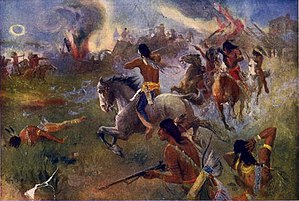Battles of New Ulm
| Battles of New Ulm | |||||||
|---|---|---|---|---|---|---|---|
| Part of the Dakota War of 1862 | |||||||
 The Siege of New Ulm, Minnesota on August 19, 1862 |
|||||||
|
|||||||
| Belligerents | |||||||
|
|
Santee Sioux | ||||||
| Commanders and leaders | |||||||
| Col. Charles Eugene Flandrau, Captain Jacob Nix, Sheriff Charles Roos | Chiefs Mankato, Wabasha, [Little Crow] and Big Eagle | ||||||
| Strength | |||||||
| 20–55 (first battle) 300 (second battle) (approx. 2,000 unarmed elderly, women, and children) | 100 (first battle), 650 (second battle) |
||||||
| Casualties and losses | |||||||
| 5 killed and 6 wounded (first battle) 34 (second battle) {Note Flandrau reported casualties as 10 killed and 50 wounded} |
Unknown | ||||||
The Battles of New Ulm were two battles in August of the Dakota War of 1862. The settlement of New Ulm, Minnesota, had 900 settlers around the time and was the largest settlement near the Sioux reservation. After the Battle of Fort Ridgely, the town was seen as a tempting target for a Sioux attack. The topography of the town also presented an advantage for the Sioux, since the land rises some 200 feet out of the Minnesota River valley in two large steps (terraces), with wooded area to provide cover for an attack.
In 1851, the Santee Sioux Indians of Minnesota had been forced to cede to the government their hunting ground of 24,000,000 acres (97,000 km2). In 1852, they were corralled into a reservation on the Minnesota River. In 1858, they were swindled of half that land. In August 1862, when the government failed to pay the $1.4 million compensation provided by treaty, and its agents and politicians stole most of the supplies that the treaty granted, the Indians rebelled. When Chief Little Crow complained that despite stacks of provisions in clear sight, supposedly theirs by treaty, his people had nothing to eat, the government agent responded, "So far as I'm concerned ... let them eat grass or their own dung. Minnesota political leaders, led by Governor Alexander Ramsey, in league with commercial interests, advocated expelling all Indians from Minnesota.
On August 18, 1862, Dakota warriors began attacking civilians without discretion to age or gender in Milford, killing 54 people and wounding many more. At the same time a recruiting party for Civil War volunteers left New Ulm, but was ambushed in Milford Township. The survivors raced back to town and warned the settlers of an impending attack. At first Sheriff Charles Roos assumed that only a few drunk Dakota were responsible and rushed with men to control the situation. After finding mutilated corpses and being fired upon, he realized that the attacks were much more serious. He then returned to New Ulm and wrote to Governor Alexander Ramsey for immediate aid. Franz Czeigowitz, a former Austrian soldier, had already organized about 50 poorly armed citizens into a defensive militia. At that time they only had 12 rifles, the rest being armed with shotguns and other poor quality firearms or farm tools. Roos soon turned over command to Jacob Nix, a veteran of revolutionary fighting in the 1848 rebellions in Europe. The townspeople prepared for the attack by erecting barricades on the streets and packing the women and children into three available brick buildings. The first attack came on August 19, with about 100 Sioux warriors firing on the city from the bluff behind the town. Under the command of Jacob Nix a small number of civilians returned the fire as best as they could. Later in the day, a thunderstorm discouraged the Indians from continuing their attack, and there were no chiefs present to give orders. The first battle ended with six settlers killed (including eleven year old Emily Pauli) and five wounded (including Nix who lost a finger).
...
Wikipedia
